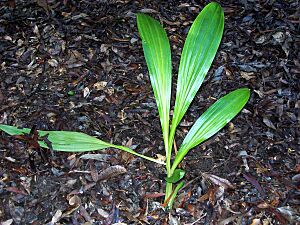Southern swamp orchid facts for kids
Quick facts for kids Southern swamp orchid |
|
|---|---|
 |
|
| Phaius tankervilleae var. australis at the Royal Botanic Gardens, Sydney | |
| Conservation status | |
| Scientific classification |
|
| Kingdom: | Plantae |
| Clade: | Tracheophytes |
| Clade: | Angiosperms |
| Clade: | Monocots |
| Order: | Asparagales |
| Family: | Orchidaceae |
| Subfamily: | Epidendroideae |
| Genus: | Phaius |
| Species: | |
| Varietas: |
P. t. var. australis
|
| Trinomial name | |
| Phaius tankervilleae var. australis (F.Muell.) J.V.Stone & P.J.Cribb
|
|
| Synonyms | |
|
|
The Phaius tankervilleae var. australis, also known as the common swamp orchid, southern swamp-orchid, swamp lily or island swamp-orchid, is a special type of orchid. It grows naturally only in eastern Australia. This plant is an evergreen land plant that stays green all year. It has large, crowded pseudobulbs, big pleated leaves, and flowers that are reddish-brown on the inside and white on the outside.
Contents
About the Southern Swamp Orchid
The Southern Swamp Orchid is a beautiful plant that grows on land and stays green all the time. It has thick, crowded parts called pseudobulbs, which are like storage organs. These pseudobulbs are about 5 to 7 centimeters (2 to 3 inches) long and wide.
What Does It Look Like?
This orchid has between four and eight dark green leaves. These leaves are shaped like a spear, wider in the middle and narrower at the base. They are quite long, about 50 to 125 centimeters (20 to 49 inches) long, and 8 to 10 centimeters (3 to 4 inches) wide. The leaves have a cool pleated or folded look.

The flowers are very impressive. There are usually 4 to 16 fleshy flowers on a thick stem that can grow up to 2 meters (6.6 feet) tall. Each flower is large, about 6 to 10 centimeters (2 to 4 inches) long and 6.5 to 11 centimeters (2.6 to 4.3 inches) wide. They are the biggest flowers of all Australian orchids! The inside of the flowers is reddish-brown, and the outside is white.
The flower parts include sepals and petals. The sepals are about 4.5 to 5.5 centimeters (1.8 to 2.2 inches) long. The top sepal points upwards, and the side sepals spread out wide. The petals are similar in size to the sepals. The labellum, which is a special lip-like petal, is about 5 to 6 centimeters (2.0 to 2.4 inches) long and 4 to 4.5 centimeters (1.6 to 1.8 inches) wide. It has three parts, or lobes, and can be yellow to bright purple. The middle lobe often has wavy or crinkly edges. These orchids usually bloom between September and November in Australia.
Where Does This Orchid Live?
The Southern Swamp Orchid grows in swampy forests close to the coast. You can find it from Cooktown in Queensland down to Lake Cathie in New South Wales. It often forms large groups, especially in swamps where Melaleuca quinquenervia trees grow, and in wet forests.
Protecting the Southern Swamp Orchid
Sadly, the Southern Swamp Orchid is an "endangered" species. This means it is at high risk of disappearing forever. Both the Australian Government and the New South Wales Government have laws to protect it.
Why Is It Endangered?
There are a few main reasons why this orchid is in danger:
- Illegal Collection: Some people illegally collect the plants and their beautiful flowers from the wild.
- Habitat Loss: The places where these orchids grow are being destroyed. This happens when land is cleared for buildings or farms.
- Weed Invasion: Harmful weeds like lantana and umbrella tree (Schefflera actinophylla) invade the orchid's habitat. These weeds can outcompete the orchids for space, light, and nutrients.
Growing Southern Swamp Orchids
This orchid is quite easy to grow in gardens. It likes places with some shade, not full sun. You can grow new plants from seeds or by cutting a piece from the base of an existing plant. The flowers are not only pretty but also smell nice. They usually appear from late August to October.
Another way to grow new plants is from the flower stem. After the orchid finishes flowering, you can lay the stem (or parts of it) on wet moss or put it in a container of water. Small new plants will start to grow from the nodes (small bumps) on the stem. Once they are big enough, you can carefully remove them and plant them in their own pots.


